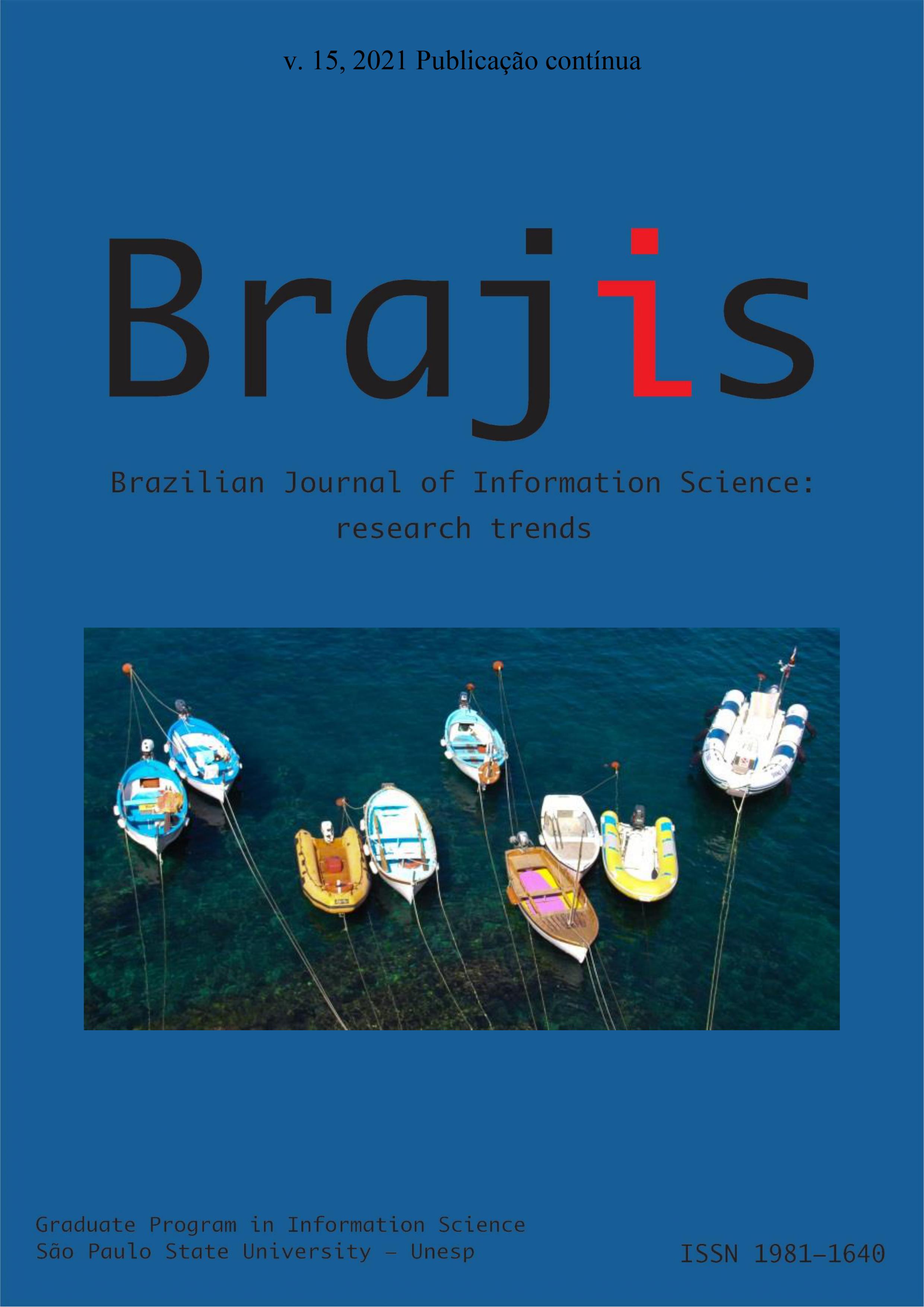Eye tracking and pupil reactions in User Experience studies
DOI:
https://doi.org/10.36311/1981-1640.2021.v15.e02113Keywords:
Eye tracking, User experience, Pupil reactions, Sentiment analysisAbstract
The constant technological advances have directed society towards an information consumption increasingly mediated by Information and Communication Technologies interfaces, reflecting the relevance of studies that investigate the experience of human-computer interaction in Information Science. This article aims to perform a literature review on eye tracking studies and pupil reactions in User Experience studies. It has a quanti-qualitative approach, being characterized under the point of view of its objectives as exploratory. The bibliographical survey resulted in 100 articles for analysis, six of which were selected at the end of the selection because they included the application of the eye tracker instrument, studied pupil reactions, and presented methods that could be used or adapted for the Information Science. It was noticed that all the selected studies used the eye tracker instrument, along with another measure of environmental control of the studies, for the analysis of feelings through pupil reactions. It is concluded that the methodologies used by other areas are characterized as possibilities for the development of investigations within Information Science.
Downloads
References
Araújo, C. A. A. O que é ciência da informação. KMA, 2018.
Baharom, N. H., et al. “Positive emotion recognition through eye tracking technology”, Journal of Advanced Manufacturing Technology, vol. 13, no. 1, 2019, pp. 143-152, no. special, https://jamt.utem.edu.my/jamt/article/view/5683/3857. Acessado 10 fev. 2021.
Bojko, A. Eye tracking the user experience a practical guide to research. Rosenfeld, 2013.
Ferreira, A. M. J. F. C., et al. Anais do 6º Seminário em Ciência da Informação: fenômenos emergentes na Ciência da Informação, Universidade Estadual de Londrina, 2016.
International Organization for Standardization. ISO 690:2010(EN): Information and documentation – Guidelines for bibliographic references and citations to information resources, https://www.iso.org/ui/#iso:std:iso:690:ed-3:v1:en. Acessado 15 abr. 2021.
Marshall, S. P. “Method and apparatus for eye tracking and monitoring pupil dilation to evaluate cognitive activity”, Current assignee: eye tracking LLC, San Diego State University Research Foundation, Patent Number: 6,090,051, Publication date: 3 Mar. 1999, Priority date: 18 Jul 2000, https://patents.google.com/patent/US6090051A/en. Acessado 10 fev. 2021.
Prodanov, C. C. and Freitas, E. C. Metodologia do trabalho científico: métodos e técnicas da pesquisa e do trabalho acadêmico. 2. ed. Feevale, 2013.
Roa-Martínez, S. M. and Vidotti, S. A. B. G. “Eye tracking y usabilidad em ambientes informacionales digitales: revisión teórica y propuesta de procedimiento de evaluación”, Transinformação, vol. 32, Epub fev. 2020, doi: 10.1590/1678-9865202032e190067. Acessado 10 fev. 2021.
Rodas, C. M., et al. “Interface de busca do Google e Yahoo: a experiência do usuário sob o olhar do eye tracking”, Inf. & Soc.: Est., vol. 26, no. 2, maio/ago. 2016, pp. 37-50, https://core.ac.uk/download/pdf/296778038.pdf. Acessado 20 abr. 2021.
Rodas, C. M. Padrão de comportamento na busca de informação em mecanismo de busca: um enfoque com a tecnologia de eye tracking, 2017. Faculdade de Filosofia e Ciências, Universidade Estadual Paulista, Tese de Doutorado.
Sepúlveda, M. I. M. and Araújo, C. A. A. “Realização de estudos de usuários na prática profissional bibliotecária: um estudo de caso do sistema de bibliotecas da UFMG”, Revista ACB, vol. 17, no. 2, set. 2012, pp. 269-287, https://revista.acbsc.org.br/racb/article/view/842/pdf. Acessado 15 abr. 2021.
Schall, A. and Bergstrom, J. R. Eye tracking in user experience design. Elsevier, 2014.
Tobii Pro. Webinar: the power of the pupil, 2020, https://www.tobiipro.com/news-events/events/webinar-the-power-of-the-pupil/webinar-recording/. Acessado 10 jan. 2021.
Tullis, T. and Albert, B. Measuring the user experience: collecting, analyzing, and presenting usability metrics. 2. ed. Elsevier, 2013.
Vidotti, S. A. B. G., et al. “Arquitetura da informação e o eye tracking: o que o olhar e os dados revelam”. Informação & Tecnologia, vol. 3, no. 1, jan./jun. 2016, pp. 181-202, doi: 10.22478/ufpb.1981-0695.2018v13n2.42941. Acessado 10 fev. 2021.
Downloads
Published
Issue
Section
License
Copyright (c) 2021 Suellen Elise Timm Barros, Heytor Diniz Teixeira, Cecilio Merlotti Rodas, Silvana Aparecida Borsetti Gregorio Vidotti, Rachel Cristina Vesu Alves

This work is licensed under a Creative Commons Attribution-ShareAlike 4.0 International License.
When submitting an article, the authors retain the copyright of the article, giving full rights to the Brazilian Journal of Information Science to publish the text.
The author(s) agree that the article, if editorially accepted for publication, shall be licensed under the Creative Commons Attribution-ShareAlike 4.0 International (CC BY-SA 4.0) license (http://creativecommons.org/licenses/by-sa/4.0) Readers/users are free to: - Share — copy and redistribute the material in any medium or format - Adapt — remix, transform, and build upon the material for any purpose, even commercially. The licensor cannot revoke these freedoms as long as you follow the license terms. Under the following terms: - Attribution — You must give appropriate credit, provide a link to the license, and indicate if changes were made. You may do so in any reasonable manner, but not in any way that suggests the licensor endorses you or your use. - ShareAlike — If you remix, transform, or build upon the material, you must distribute your contributions under the same license as the original. No additional restrictions — You may not apply legal terms or technological measures that legally restrict others from doing anything the license permits. Notices: - You do not have to comply with the license for elements of the material in the public domain or where your use is permitted by an applicable exception or limitation. - No warranties are given. The license may not give you all of the permissions necessary for your intended use. For example, other rights such as publicity, privacy, or moral rights may limit how you use the material.
 Creative Commons Attribution-ShareAlike 4.0 International License.
Creative Commons Attribution-ShareAlike 4.0 International License.







